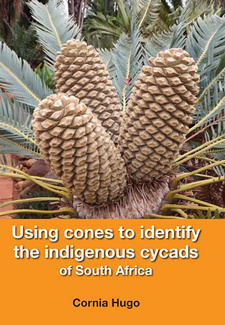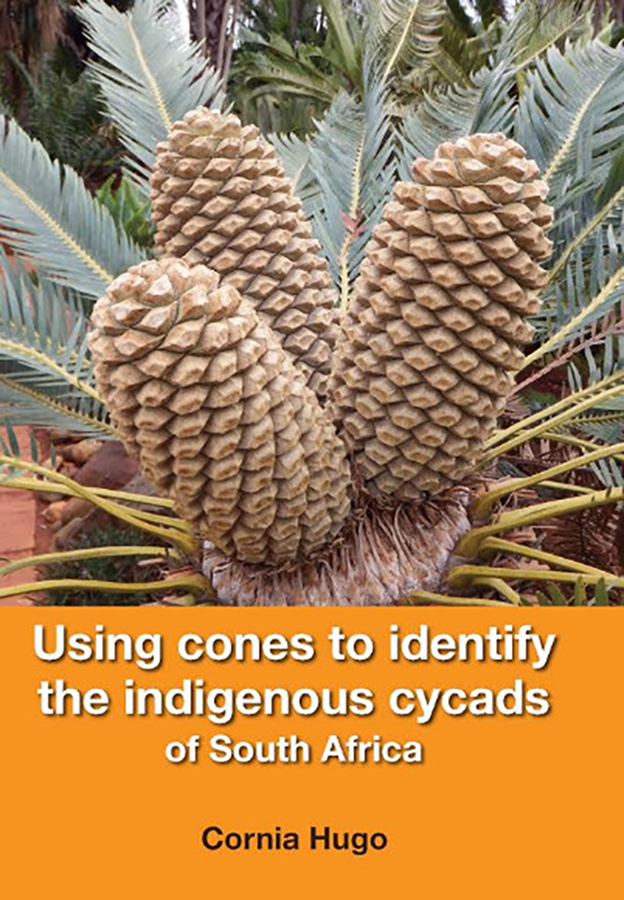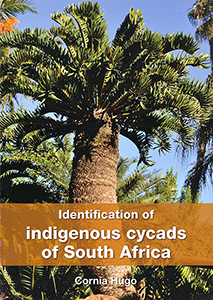Using cones to identify the indigenous Cycads of South Africa, by Cornia Hugo

Using cones to identify the indigenous Cycads of South Africa, by Cornia Hugo. Briza Publications. Expanded and revised 2nd edition. Pretoria, South Africa 2017. ISBN 9780620697675 / ISBN 978-0-620-69767-5
Using cones to identify the indigenous Cycads of South Africa by Cornia Hugo was developed with the layman in mind for practical use in the field or garden. It is not intended as a scientific taxonomic publication on the indigenous cycad species.
Legal Aspects Pertaining To Cycads From South Africa
1. Overview of Relevant Legislation
Please note that the contents of this section are accurate at time of print and are subject to amendment. The legislation might thus change in future. Prior to promulgation of the National Environmental Management Biodiversity Act, Act 10 of 2004 (NEMBA), and its Threatened or Protected Species Regulations of 2007 (TOPS), cycad conservation was regulated by various provincial Ordinances, and Acts. The TOPS regulations however apply only to species that are listed as threatened or protected in terms of the NEMBA, whereas provincial legislation still applies to all species, including those not listed as threatened or protected. The National Environmental Management: Biodiversity Act, Act 10 of 2004 (NEMBA) regulates the management and conservation of South Africa's biodiversity and its components, and affords protection to species and ecosystems that are in need of national protection. The regulations pertaining to Threatened or Protected Species (National Environmental Management: Biodiversity Act, Act 10 of 2004), which list all cycad species as Critically Endangered, Endangered, Vulnerable and Protected, came into effect on 1 February 2008. The aim of these regulations is to effectively regulate the trade in and utilization of indigenous cycad species. Internationally, provisions of the International Conventions on the Trade in Endangered Species of Wild Fauna and Flora (CITES), to which South Africa is a signatory, aim to ensure that international trade in specimens of animals and plant species is not detrimental to their survival in the wild. These provisions need to be effected in terms of national legislation, hence the development of the CITES Regulations in terms of NEMBA. NEMBA has declared all South Africa cycads as threatened and protected species, and divided under the classifications of critically endangered, endangered, vulnerable and protected. NEMBA has declared a number of activities related to cycads as restricted, and anyone wishing to conduct any of these activities must be in possession of a permit.
2. Glossary Of Terms
Artificially propagated: Means a listed threatened or protected plant species that is grown under controlled conditions; grown from seeds, cuttings, divisions, callus tissues or other plant tissues, spores or other propagules derived from cultivated parental stock.
Biodiversity Act: Means the National Environmental Management: Biodversity Act, 2004 (Act No 10 of 2004)
CITES: Convention on International Trade in Endangered Species of Wild Fauna and Flora.
Critically Endangered: (in terms of Section 56 of NEMBA) Indigenous species facing an extremely high risk of extinction in the wild in the immediate future.
Commercial purposes: In relation to a restricted activity involving a specimen of a listed threatened or protected species, means that the primary purpose of the restricted activity is to obtain economic benefit, including profit in cash or in kind, and is directed towards, trade, exchange or another form of economic use or benefit. [...]
This is an excerpt from: Using cones to identify the indigenous Cycads of South Africa, by Cornia Hugo.
Title: Using cones to identify the indigenous Cycads of South Africa
Authors: Cornia Hugo
Publisher: Briza Publications
Expanded and revised 2nd edition. Pretoria, South Africa 2017
ISBN 9780620697675 / ISBN 978-0-620-69767-5
Softcover, 17 x 24 cm, 118 pages, 530 colour photographs
Hugo, Cornia im Namibiana-Buchangebot
Using cones to identify the indigenous Cycads of South Africa
This is a practical easy-to-use guide, by using cones for the identification of indigenous cycad species (Encephalartos species) of South Africa.
Identification of indigenous cycads of South Africa
This guide is a practical easy-to-use guide for the identification of indigenous cycad species of the genus Encephalartos of South Africa.


